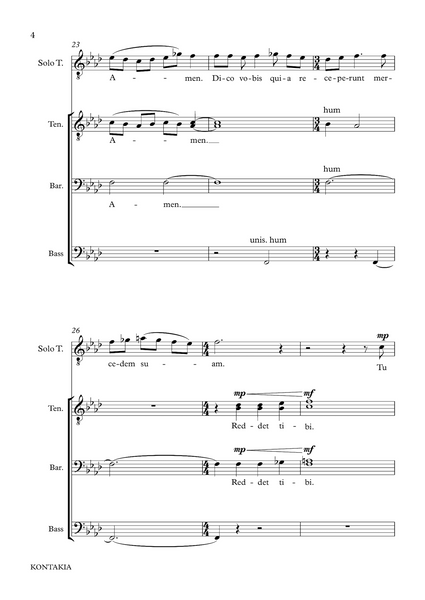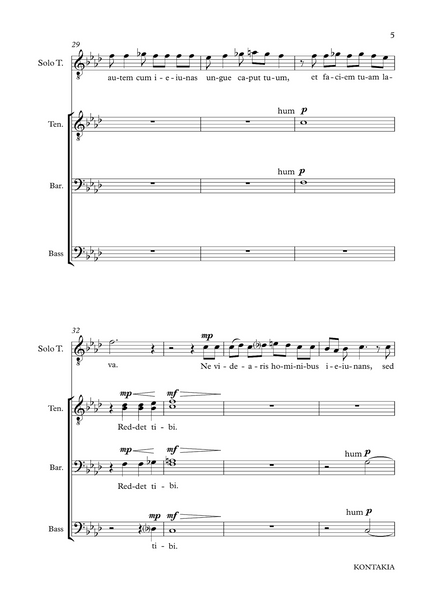Lydia Kakabadse: Kontakia – for male voice choir (NXP161)
This is a sheet music edition of Kontakia by the composer Lydia Kakabadse.
Sheet music for male voice choir
Score: 40 pages
Duration: 15:22 minutes
Audio sample
Preface and programme notes
Kontakia is my second choral work for unaccompanied male voice choir and was completed in January 2015 following Cantica Sacra. It is made up of 5 kontakions and is set to sacred Latin texts taken from Psalms, Matthew, Mark and John, representing the religious observance of Lent in the liturgical calendar. Kontakia incorporates a number of features which epitomise the Russian Orthodox liturgy namely, chanting, specific melodic cadences, bass drone effects, antiphons and responses, open triads, augmented 2nd intervals and consecutive diminished 7th chords resolving to tonic.
Kontakia is the plural form of kontakion, which derives from the Greek word meaning “pole”, around which a scroll containing texts was wound. The scroll would unfurl as the texts were read. Kontakion is a type of thematic hymn performed in the Eastern Orthodox Church and was significant in early Byzantine liturgical music.
The work commences with Those who shall be Rewarded, where a solo tenor enters over slow moving chords hummed by the choir and delivers verses 16-18 from Matthew 6 in a high register, alternating with the choir’s repeated refrains: Amen and reddet tibi (he will repay you). This is followed by a faster, brighter and more melodious kontakion A Shimmering Vision with antiphonal singing taking place between the voices.
It also includes chanting in A minor by the tenor solo representing the Father: hic est Filius meus carissimus audite illum (this is my beloved Son, hear ye him) ending in the major key using the following melodic configuration: tonic – leading note – submediant – tonic. This cadence pattern, which also appears after each of the solo tenor’s chants in The Devil’s Torment, is widely used in the Russian Orthodox liturgy.
Those who shall be Protected is characterized by antiphonal singing, much interaction between the voices and includes two short entries by the solo tenor over an open chord and bare 5th. In The Devil’s Torment, where much use is made of augmented 2nd intervals, the tenor solo (representing Jesus Christ) and the bass solo singing in a low register (representing the devil) alternate with the choir in the story telling of Jesus Christ being led into the desert to be tempted by the devil.
The dialogue between Christ and the devil in respect of each of the 3 temptations takes the form of monotone chants. Whilst the first theme in Six Days before Easter is introduced by the solo tenor in monophonic style and in free rhythm, the second theme is delivered (and later developed) by the solo tenor over held chords by the choir.
Both themes are developed by each of the voices in a mostly flowing style through to the end.




















